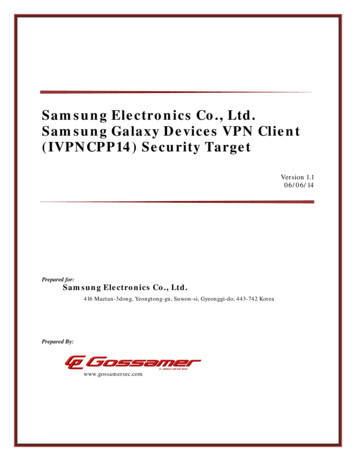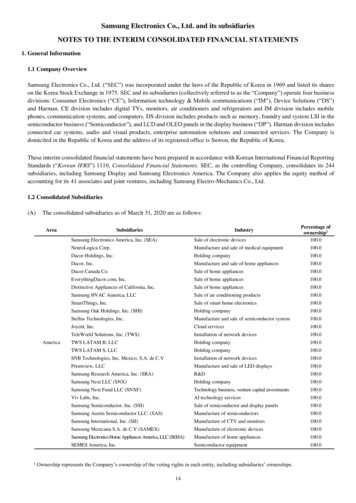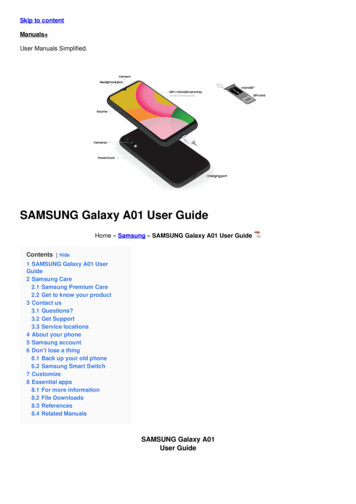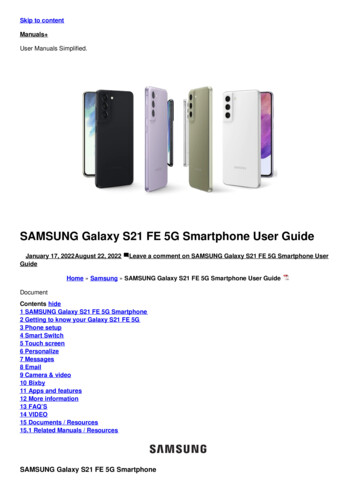
Transcription
Samsung Electronics Co., Ltd.Samsung Galaxy Devices VPN Client(IVPNCPP14) Security TargetVersion 1.106/06/14Prepared for:Samsung Electronics Co., Ltd.416 Maetan-3dong, Yeongtong-gu, Suwon-si, Gyeonggi-do, 443-742 KoreaPrepared By:www.gossamersec.com
Samsung Electronics Co., Ltd. Samsung Galaxy Devices VPN Client(IVPNCPP14) Security Target1.Version 1.1 06/06/14SECURITY TARGET INTRODUCTION .31.1SECURITY TARGET REFERENCE .31.2TOE REFERENCE .41.3TOE OVERVIEW .41.4TOE DESCRIPTION .41.4.1TOE Architecture .51.4.2TOE Documentation .62.CONFORMANCE CLAIMS .72.13.CONFORMANCE RATIONALE .7SECURITY OBJECTIVES .83.1SECURITY OBJECTIVES FOR THE ENVIRONMENT.84.EXTENDED COMPONENTS DEFINITION .95.SECURITY REQUIREMENTS . 105.1TOE SECURITY FUNCTIONAL REQUIREMENTS . 105.1.1Cryptographic support (FCS) . 115.1.2User data protection (FDP) . 135.1.3Identification and authentication (FIA) . 135.1.4Security management (FMT) . 145.1.5Protection of the TSF (FPT) . 155.1.6Trusted path/channels (FTP) . 155.2TOE SECURITY ASSURANCE REQUIREMENTS. 155.2.1Development (ADV) . 165.2.2Guidance documents (AGD) . 165.2.3Life-cycle support (ALC) . 175.2.4Tests (ATE) . 185.2.5Vulnerability assessment (AVA) . 186.TOE SUMMARY SPECIFICATION . 196.16.26.36.46.56.6CRYPTOGRAPHIC SUPPORT . 19USER DATA PROTECTION . 21IDENTIFICATION AND AUTHENTICATION . 21SECURITY MANAGEMENT . 22PROTECTION OF THE TSF . 22TRUSTED PATH/CHANNELS . 23LIST OF TABLESTable 1 TOE Security Functional Components . 11Table 2 EAL 1 Assurance Components . 16Table 3 TOE Keys and Secrets . 20Page 2 of 23
Samsung Electronics Co., Ltd. Samsung Galaxy Devices VPN Client(IVPNCPP14) Security TargetVersion 1.1 06/06/141. Security Target IntroductionThis section identifies the Security Target (ST) and Target of Evaluation (TOE) identification, ST conventions, STconformance claims, and the ST organization. The TOE consists of the Samsung Galaxy Devices VPN Clientprovided by Samsung Electronics Co., Ltd. The TOE is being evaluated as an IPsec VPN Client.The Security Target contains the following additional sections: Conformance Claims (Section 2) Security Objectives (Section 3) Extended Components Definition (Section 4) Security Requirements (Section 5) TOE Summary Specification (Section 6)ConventionsThe following conventions have been applied in this document: Security Functional Requirements – Part 2 of the CC defines the approved set of operations that may beapplied to functional requirements: iteration, assignment, selection, and refinement.oIteration: allows a component to be used more than once with varying operations. In the ST,iteration is indicated by a letter placed at the end of the component. For example FDP ACC.1aand FDP ACC.1b indicate that the ST includes two iterations of the FDP ACC.1 requirement, aand b.oAssignment: allows the specification of an identified parameter. Assignments are indicated usingbold and are surrounded by brackets (e.g., [assignment]). Note that an assignment within aselection would be identified in italics and with embedded bold brackets (e.g., [[selectedassignment]]).oSelection: allows the specification of one or more elements from a list. Selections are indicatedusing bold italics and are surrounded by brackets (e.g., [selection]).oRefinement: allows the addition of details. Refinements are indicated using bold, for additions,and strike-through, for deletions (e.g., “ all objects ” or “ some big things ”). The IVPNCPP uses an additional convention – the ‘case’ – which defines parts of an SFR that apply onlywhen corresponding selections are made or some other identified conditions exist. Only the applicablecases are identified in this ST and they are identified using bold text. Other sections of the ST – Other sections of the ST use bolding to highlight text of special interest, such ascaptions.1.1 Security Target ReferenceST Title – Samsung Electronics Co., Ltd. Samsung Galaxy Devices VPN Client (IVPNCPP14) Security TargetST Version – Version 1.1ST Date – 06/06/14Page 3 of 23
Samsung Electronics Co., Ltd. Samsung Galaxy Devices VPN Client(IVPNCPP14) Security TargetVersion 1.1 06/06/141.2 TOE ReferenceTOE Identification – Samsung Electronics Co., Ltd. Samsung Galaxy Devices VPN Client including the GalaxyS4, Galaxy Note 3, Galaxy Note 10.1 2014 Edition, Galaxy NotePRO Tablet, and Galaxy S5.TOE Developer – Samsung Electronics Co., Ltd.Evaluation Sponsor – Samsung Electronics Co., Ltd.1.3 TOE OverviewThe Target of Evaluation (TOE) is Samsung Galaxy Devices with Qualcomm Snapdragon Processors including theGalaxy S4, Galaxy Note 3, Galaxy Note 10.1 2014 Edition, Galaxy NotePRO Tablet, and Galaxy S5. This STfocuses on the IPSEC VPN capabilities of the TOE. The IPSec VPN allows users the ability to have confidentiality,integrity, and protection of data in transit, even though it traverses a public network.1.4 TOE DescriptionThe TOE is a mobile operating system based on Android 4.4 with modifications made to increase the level ofsecurity provided to end users and enterprises. The TOE is intended to be used as part of an enterprise messagingsolution providing mobile staff with enterprise connectivity.The evaluated versions of the mobile devices are as follows. Android version: 4.4.2 Kernel version: 3.4.0 Build number: KOT49H Security software version: MDF v1.0 Release 3, VPN v1.4 Release 2The model numbers of the mobile devices are as follows.Device NameBase Model NumberGalaxy Note 3SM-N900Galaxy NotePROSM-N905Galaxy Note 10.1 2014 Ed.SM-P605Galaxy S5SM-G900These devices may include an additional letter or number at the end of the name (such as SM-N900V) that denotesthe device is for a specific carrier (V Verizon Wireless).The Galaxy S4 had unique model numbers for each US carrier as listed below:CarrierGalaxy eSGH-M919US CellularSCH-R970InternationalGT-I9505The TOE includes a Common Criteria mode (or “CC mode”) that an administrator can invoke through the use of anMDM or through the installation and use of the administrative application, CCMode.apk. The TOE must beconfigured as follows in order for an administrator to transition the TOE to CC mode. Require a screen lock password (swipe, PIN, pattern, or facial recognition screen locks are not allowed).Page 4 of 23
Samsung Electronics Co., Ltd. Samsung Galaxy Devices VPN Client(IVPNCPP14) Security Target Version 1.1 06/06/14The maximum password failure retry policy should be less than or equal to ten.Device encryption must be enabled.SDCard encryption must be enabled.Revocation checking must be enabled.When CC mode has been enabled, the TOE behaves as follows. The TOE restricts the available VPN configurations to those evaluated as part of this evaluation. The TOE restricts the use of IKEv2/IPsec cipher suites to only those conformant with the requirements ofthe IVPNCPP14.1.4.1 TOE ArchitectureThe TOE combines with a Mobile Device Management solution that enables the enterprise to watch, control andadminister all deployed mobile devices, across multiple mobile service providers as well as facilitate securecommunications through a VPN. This partnership provides a secure mobile environment that can be managed andcontrolled by the environment and reduce the risks that can be introduced through a Bring-Your-Own-Device(BYOD) model.Data on the TOE is protected through the implementation of Samsung On-Device Encryption (ODE) which utilizesa FIPS 140-2 certified cryptographic modules to encrypt device and SD card storage. This functionality is combinedwith a number of on-device policies including local wipe, remote wipe, password complexity, automatic lock andprivileged access to security configurations to prevent unauthorized access to the device and stored data.The Samsung Enterprise Software Development Kit (SDK) builds on top of the existing Android security model byexpanding the current set of security configuration of options to more than 390 configurable policies and includingadditional security functionality such as application whitelisting and blacklisting.1.4.1.1 Physical BoundariesThe TOE is a multi-user operating system based on Android (4.4) that incorporates the Samsung Enterprise SDK.The TOE does not include the user applications that run on top of the operating system, but does include controlsthat limit application behavior. The method of use for the TOE is as a mobile messaging and VPN device for usewithin an enterprise environment where the configuration of the device is managed through a compliant devicemanagement solution.The TOE communicates and interacts with 802.11-2012 Access Points and cellular networks to establish networkconnectivity.This evaluation does not include the underlying hardware and firmware or the device management application that isimplemented on the device.1.4.1.2 Logical BoundariesThis section summarizes the security functions provided by the Samsung Galaxy Devices VPN Client: Cryptographic support User data protection Identification and authentication Security management Protection of the TSFPage 5 of 23
Samsung Electronics Co., Ltd. Samsung Galaxy Devices VPN Client(IVPNCPP14) Security Target Version 1.1 06/06/14Trusted path/channels1.4.1.2.1 Cryptographic supportThe IPsec implementation is the primary function of the TOE. IPSec is used by the TOE to protect communicationbetween itself and a VPN Gateway over an unprotected network. With the exception of the IPsec implementation,the TOE relies upon its underlying platform (evaluated against the Protection Profile For Mobile DeviceFundamentals) for the cryptographic services specified in this Security Target.1.4.1.2.2 User data protectionThe TOE ensures that residual information is protected from potential reuse in accessible objects such as networkpackets.1.4.1.2.3 Identification and authenticationThe TOE provides the ability to use, store, and protect X.509 certificates and pre-shared keys that are used for IPsecVirtual Private Network (VPN) connections.1.4.1.2.4 Security managementThe TOE provides all the interfaces necessary to manage the security functions identified throughout this SecurityTarget. In particular, the IPsec VPN is fully configurable by a combination of functions provided directly by TheTOE and those available to the associated VPN gateway.1.4.1.2.5 Protection of the TSFThe TOE relies upon its underlying platform to perform self-tests that cover the TOE as well as the functionsnecessary to securely update the TOE.1.4.1.2.6 Trusted path/channelsThe TOE acts as a VPN client using IPsec to established secure channels to corresponding VPN gateways.1.4.2 TOE DocumentationSamsung VPN Client on Galaxy Devices Guidance documentation, Version 0.7, June 6, 2104.Samsung VPN Client on Galaxy Devices VPN User Guidance Documentation, Version 0.6, June 6, 2014.Page 6 of 23
Samsung Electronics Co., Ltd. Samsung Galaxy Devices VPN Client(IVPNCPP14) Security TargetVersion 1.1 06/06/142. Conformance ClaimsThis TOE is conformant to the following CC specifications: Common Criteria for Information Technology Security Evaluation Part 2: Security functional components,Version 3.1, Revision 4, September 2012. Part 2 ExtendedCommon Criteria for Information Technology Security Evaluation Part 3: Security assurance components,Version 3.1 Revision 4, September 2012. Part 3 Conformant Protection Profile for IPsec Virtual Private Network (VPN) Clients, Version 1.4, 21 October 2013(IVPNCPP14) Package Claims: Assurance Level: EAL 1-conformant2.1 Conformance RationaleThe ST conforms to the IVPNCPP14. As explained previously, the security problem definition, security objectives,and security requirements have been drawn from the PP.Page 7 of 23
Samsung Electronics Co., Ltd. Samsung Galaxy Devices VPN Client(IVPNCPP14) Security TargetVersion 1.1 06/06/143. Security ObjectivesThe Security Problem Definition may be found in the IVPNCPP14 and this section reproduces only thecorresponding Security Objectives for operational environment for reader convenience. The IVPNCPP14 offersadditional information about the identified security objectives, but that has not been reproduced here and theIVPNCPP14 should be consulted if there is interest in that material.In general, the IVPNCPP14 has defined Security Objectives appropriate for IPsec VPN Client and as such areapplicable to the Samsung Galaxy Devices with Qualcomm Snapdragon Processors TOE.3.1 Security Objectives for the Environment OE.NO TOE BYPASS Information cannot flow onto the network to which the VPN client's host isconnected without passing through the TOE. OE.PHYSICAL Physical security, commensurate with the value of the TOE and the data it contains, isassumed to be provided by the operational environment. OE.TRUSTED CONFIG Personnel configuring the TOE and its operational environment will follow theapplicable security configuration guidance.Page 8 of 23
Samsung Electronics Co., Ltd. Samsung Galaxy Devices VPN Client(IVPNCPP14) Security TargetVersion 1.1 06/06/144. Extended Components DefinitionAll of the extended requirements in this ST have been drawn from the IVPNCPP14. The IVPNCPP14 defines thefollowing extended SFRs and SARs and since they are not redefined in this ST the IVPNCPP14 should be consultedfor more information in regard to those CC extensions. FCS CKM EXT.2: Cryptographic Key Storage FCS CKM EXT.4: Cryptographic Key Zeroization FCS IPSEC EXT.1: Extended: Internet Protocol Security (IPsec) Communications FCS RBG EXT.1: Extended: Cryptographic operation (Random Bit Generation) FIA X509 EXT.1: Extended: X.509 Certificate Validation FIA X509 EXT.2: Extended: X.509 Certificate Use and Management FPT TST EXT.1: Extended: TSF Self Test FPT TUD EXT.1: Extended: Trusted Update FIA PSK EXT.1: Extended: Pre-Shared Key CompositionPage 9 of 23
Samsung Electronics Co., Ltd. Samsung Galaxy Devices VPN Client(IVPNCPP14) Security TargetVersion 1.1 06/06/145. Security RequirementsThis section defines the Security Functional Requirements (SFRs) and Security Assurance Requirements (SARs)that serve to represent the security functional claims for the Target of Evaluation (TOE) and to scope the evaluationeffort.The SFRs have all been drawn from the IVPNCPP14. The refinements and operations already performed in theIVPNCPP14 are not identified (e.g., highlighted) here, rather the requirements have been copied from theIVPNCPP14 and any residual operations have been completed herein. Of particular note, the IVPNCPP14 made anumber of refinements and completed some of the SFR operations defined in the Common Criteria (CC) and that PPshould be consulted to identify those changes if necessary.The SARs are also drawn from the IVPNCPP14 which includes all the SARs for EAL 1. However, the SARs areeffectively refined since requirement-specific 'Assurance Activities' are defined in the IVPNCPP14 that serve toensure corresponding evaluations will yield more practical and consistent assurance than the EAL 1 assurancerequirements alone. The IVPNCPP14 should be consulted for the assurance activity definitions.5.1 TOE Security Functional RequirementsThe following table identifies the SFRs that are satisfied by Samsung Galaxy Devices with Qualcomm SnapdragonProcessors TOE.Requirement ClassFCS: Cryptographic supportFDP: User data protectionFIA: Identification andauthenticationFMT: Security managementFPT: Protection of the TSFFTP: Trusted path/channelsRequirement ComponentFCS CKM.1(1): Cryptographic Key Generation (AsymmetricKeys)FCS CKM.1(2): Cryptographic Key Generation (for asymmetrickeys - IKE)FCS CKM EXT.2: Cryptographic Key StorageFCS CKM EXT.4: Cryptographic Key ZeroizationFCS COP.1(1): Cryptographic Operation (DataEncryption/Decryption)FCS COP.1(2): Cryptographic Operation (for cryptographicsignature)FCS COP.1(3): Cryptographic Operation (CryptographicHashing)FCS COP.1(4): Cryptographic Operation (Keyed-Hash MessageAuthentication)FCS IPSEC EXT.1: Extended: Internet Protocol Security (IPsec)CommunicationsFCS RBG EXT.1: Extended: Cryptographic operation (RandomBit Generation)FDP RIP.2: Full Residual Information ProtectionFIA PSK EXT.1: Extended: Pre-Shared Key CompositionFIA X509 EXT.1: Extended: X.509 Certificate ValidationFIA X509 EXT.2: Extended: X.509 Certificate Use andManagementFMT SMF.1(1): Specification of Management FunctionsFMT SMF.1(2): Specification of Management FunctionsFPT TST EXT.1: Extended: TSF Self TestFPT TUD EXT.1: Extended: Trusted UpdateFTP ITC.1: Inter-TSF trusted channelPage 10 of 23
Samsung Electronics Co., Ltd. Samsung Galaxy Devices VPN Client(IVPNCPP14) Security TargetVersion 1.1 06/06/14Table 1 TOE Security Functional Components5.1.1 Cryptographic support (FCS)5.1.1.1 Cryptographic Key Generation (Asymmetric Keys) (FCS CKM.1(1))FCS CKM.1(1).1Refinement: The [TOE Platform] shall generate asymmetric cryptographic keys used for keyestablishment in accordance with- NIST Special Publication 800-56A, 'Recommendation for Pair-Wise Key EstablishmentSchemes Using Discrete Logarithm Cryptography' for finite field-based key establishmentschemes;- NIST Special Publication 800-56A, 'Recommendation for Pair-Wise Key EstablishmentSchemes Using Discrete Logarithm Cryptography' for elliptic curve-based key establishmentschemes and implementing 'NIST curves' P-256, P-384 and [P-521] (as defined in FIPS PUB 1863, 'Digital Signature Standard')- [NIST Special Publication 800-56B, 'Recommendation for Pair-Wise Key EstablishmentSchemes Using Integer Factorization Cryptography' for RSA-based key establishment schemes]and specified cryptographic key sizes equivalent to, or greater than, a symmetric key strength of112 bits. See NIST Special Publication 800-57, 'Recommendation for Key Management' forinformation about equivalent key strengths.5.1.1.2 Cryptographic Key Generation (for asymmetric keys - IKE) (FCS CKM.1(2))FCS CKM.1(2).1Refinement: The [TOE Platform] shall generate asymmetric cryptographic keys used for IKE peerauthentication in accordance with a: [FIPS PUB 186-4, 'Digital Signature Standard (DSS)',Appendix B.4 for ECDSA schemes and implementing 'NIST curves' P-256, P-384 and [P-521];ANSI X9.31-1998, Appendix A.2.4 Using AES for RSA schemes]and specified cryptographic key sizes equivalent to, or greater than, a symmetric key strength of112 bits.5.1.1.3 Cryptographic Key Storage (FCS CKM EXT.2)FCS CKM EXT.2.1The [TOE Platform] shall store persistent secrets and private keys when not in use in platformprovided key storage.5.1.1.4 Cryptographic Key Zeroization (FCS CKM EXT.4)FCS CKM EXT.4.1Refinement: The [TOE Platform] shall zeroize all plaintext secret and private cryptographic keysand CSPs when no longer required.5.1.1.5 Cryptographic Operation (Data Encryption/Decryption) (FCS COP.1(1))FCS COP.1(1).1Refinement: The [TOE Platform] shall perform encryption and decryption in accordance with aspecified cryptographic algorithm AES operating in GCM and CBC mode with cryptographic keysizes 128-bits and 256-bits that meets the following:- FIPS PUB 197, 'Advanced Encryption Standard (AES)'- NIST SP 800-38D, NIST SP 800-38A.Page 11 of 23
Samsung Electronics Co., Ltd. Samsung Galaxy Devices VPN Client(IVPNCPP14) Security TargetVersion 1.1 06/06/145.1.1.6 Cryptographic Operation (for cryptographic signature) (FCS COP.1(2))FCS COP.1(2).1Refinement: The [TOE Platform] shall perform cryptographic signature services in accordancewith a specified cryptographic algorithm:- [FIPS PUB 186-4, 'Digital Signature Standard (DSS)', Appendix B.3 for RSA scheme, FIPSPUB 186-4, 'Digital Signature Standard', Appendix B.4 for ECDSA schemes and implementing'NIST curves' P-256, P-384 and [P-521]]and cryptographic key sizes equivalent to, or greater than, a symmetric key strength of 112 bits.5.1.1.7 Cryptographic Operation (Cryptographic Hashing) (FCS COP.1(3))FCS COP.1(3).1Refinement: The [TOE Platform] shall perform cryptographic hashing services in accordancewith a specified cryptographic algorithm [SHA-1, SHA-256, SHA-384, SHA-512] and messagedigest sizes [160, 256, 384, 512] bits that meet the following: FIPS Pub 180-4, 'Secure HashStandard.'5.1.1.8 Cryptographic Operation (Keyed-Hash Message Authentication) (FCS COP.1(4))FCS COP.1(4).1Refinement: The [TOE Platform] shall perform keyed-hash message authentication in accordancewith a specified cryptographic algorithm HMAC- [SHA-1, SHA-256, SHA-384, SHA-512], -keysize [any key sizes], and message digest size of [160, 256, 384, 512] bits that meet the following:FIPS PUB 198-1, 'The Keyed-Hash Message Authentication Code', and FIPS PUB 180-4, 'SecureHash Standard'.5.1.1.9 Extended: Internet Protocol Security (IPsec) Communications (FCS IPSEC EXT.1)FCS IPSEC EXT.1.1The [TOE] shall implement the IPsec architecture as specified in RFC 4301.FCS IPSEC EXT.1.2The [TOE] shall implement [tunnel mode].FCS IPSEC EXT.1.3The [VPN Gateway] shall have a nominal, final entry in the SPD that matches anything that isotherwise unmatched, and discards it.FCS IPSEC EXT.1.4The [TOE] shall implement the IPsec protocol ESP as defined by RFC 4303 using thecryptographic algorithms AES-GCM-128, AES-GCM-256 as specified in RFC 4106, [AES-CBC128 (specified by RFC 3602) together with a Secure Hash Algorithm (SHA)-based HMAC,AES-CBC-256 (specified by RFC 3602) together with a Secure Hash Algorithm (SHA)-basedHMAC].FCS IPSEC EXT.1.5The [TOE] shall implement the protocol: [IKEv2 as defined in RFCs 5996 (with mandatorysupport for NAT traversal as specified in section 2.23), 4307, and [no other RFCs for hashfunctions]].FCS IPSEC EXT.1.6The [TOE] shall ensure the encrypted payload in the [IKEv2] protocol uses the cryptographicalgorithms AES-CBC-128, AES-CBC-256 as specified in RFC 6379 and [no other algorithm].FCS IPSEC EXT.1.7The [TOE] shall ensure that IKEv1 Phase 1 exchanges use only main modeFCS IPSEC EXT.1.8The [TOE] shall ensure that [IKEv2 SA lifetimes can be configured by [VPN Gateway] based on[number of packets/number of bytes]].Page 12 of 23
Samsung Electronics Co., Ltd. Samsung Galaxy Devices VPN Client(IVPNCPP14) Security TargetVersion 1.1 06/06/14FCS IPSEC EXT.1.9The [TOE] shall generate the secret value x used in the IKE Diffie-Hellman key exchange ('x' ing x mod p) using the random bit generator specified in FCS RBG EXT.1, and having a length ofat least [(224, 256, or 384)] bits .FCS IPSEC EXT.1.10The [TOE] shall generate nonces used in IKE exchanges in a manner such that the probability thata specific nonce value will be repeated during the life a specific IPsec SA is less than 1 in 2 [(112,128, or 192)] .FCS IPSEC EXT.1.11The [TOE] shall ensure that all IKE protocols implement DH Groups 14 (2048-bit MODP), 19(256-bit Random ECP), and [5 (1536-bit MODP), 24 (2048-bit MODP with 256-bit POS), 20(384-bit Random ECP)].FCS IPSEC EXT.1.12The [TOE] shall ensure that all IKE protocols perform peer authentication using a [RSA, ECDSA]that use X.509v3 certificates that conform to RFC 4945 and [Pre-Shared Keys].FCS IPSEC EXT.1.13The [TOE] shall not establish an SA if the distinguished name (DN) contained in a certificate doesnot match the expected DN for the entity attempting to establish a connection.FCS IPSEC EXT.1.14The [VPN Gateway] shall be able to ensure by default that the strength of the symmetric algorithm(in terms of the number of bits in the key) negotiated to protect the [IKEv2 IKE SA] connection isgreater than or equal to the strength of the symmetric algorithm (in terms of the number of bits inthe key) negotiated to protect the [IKEv2 CHILD SA] connection.5.1.1.10 Extended: Cryptographic operation (Random Bit Generation) (FCS RBG EXT.1)FCS RBG EXT.1.1The [TOE Platform] shall perform all deterministic random bit generation services in accordancewith [NIST Special Publication 800-90A using [CTR DRBG(AES)]].FCS RBG EXT.1.2The deterministic RBG shall be seeded by an entropy source that accumulates entropy from [aplatform-based RBG] with a minimum of [256 bits] of entropy at least equal to the greatestsecurity strength (according to NIST SP 800-57) of the keys and hashes that it will generate.5.1.2 User data protection (FDP)5.1.2.1 Full Residual Information Protection (FDP RIP.2)FDP RIP.2.1The [TOE] shall enforce that any previous information content of a resource is made unavailableupon the [allocation of the resource to] all objects.5.1.3 Identification and authentication (FIA)5.1.3.1 Extended: Pre-Shared Key Composition (FIA PSK EXT.1)FIA PSK EXT.1.1The [TOE] shall be able to use pre-shared keys for IPsec.FIA PSK EXT.1.2The [TOE] shall be able to accept text-based pre-shared keys that:- are 22 characters and [[up to 64 characters]];- composed of any combination of upper and lower case letters, numbers, and special characters(that include: '!', '@', '#', ' ', '%', ' ', '&', '*', '(', and ')').FIA PSK EXT.1.3The [TOE] shall [be able to [accept] bit-based pre-shared keys].Page 13 of 23
Samsung Electronics Co., Ltd. Samsung Galaxy Devices VPN Client(IVPNCPP14) Security TargetVersion 1.1 06/06/145.1.3.2 Extended: X.509 Certificate Validation (FIA X509 EXT.1)FIA X509 EXT.1.1The [TOE] shall validate certificates in accordance with the following rules:- Perform RFC 5280 certificate validation and certificate path validation.- Validate the revocation status of the certificate using [the Online Certificate Status Protocol(OCSP) as specified in RFC 2560].- Validate the certificate path by ensuring the basicConstraints extension is present and the cA flagis set to TRUE for all CA certificates.- Validate the extendedKeyUsage field according to the following rules:o Certificates used for [no other purpose] shall have the Code Signing purpose (id-kp 3 with OID1.3.6.1.5.5.7.3.3).FIA X509 EXT.1.2The [TOE] shall only treat a certificate as a CA certificate if the following is met: thebasicConstraints extension i
The TOE is a multi-user operating system based on Android (4.4) that incorporates the Samsung Enterprise SDK. The TOE does not include the user applications that run on top of the operating system, but does include controls that limit application behavior. The method of use for the TOE is as a mobile messaging and VPN device for use











